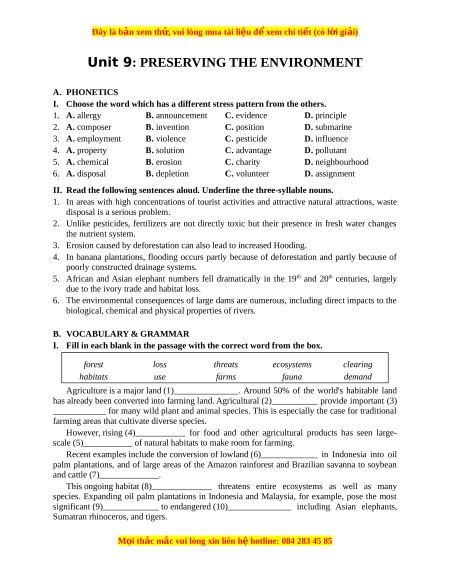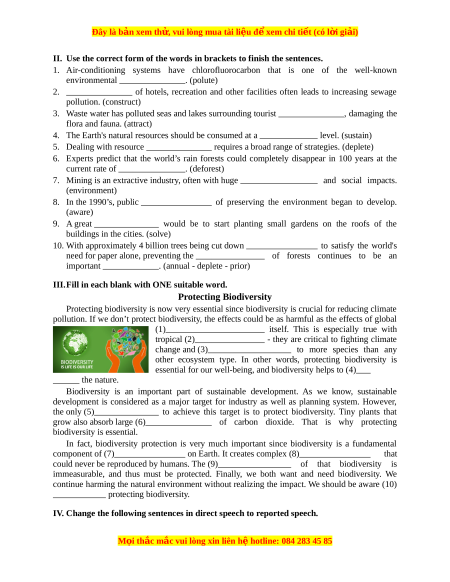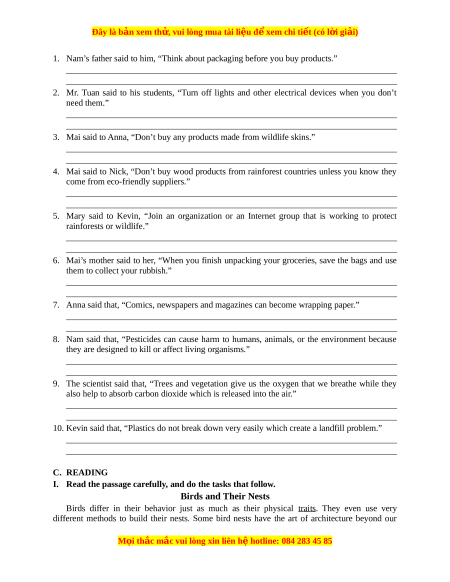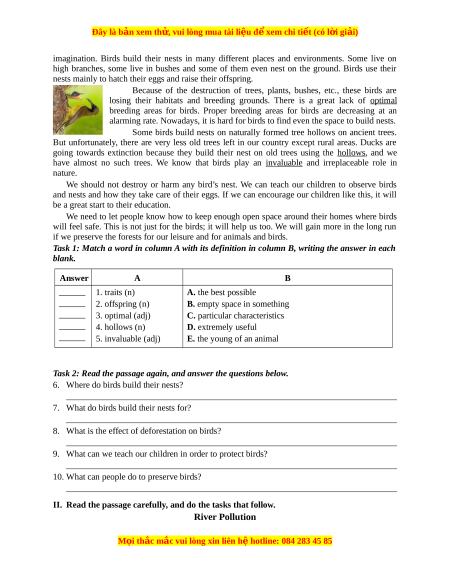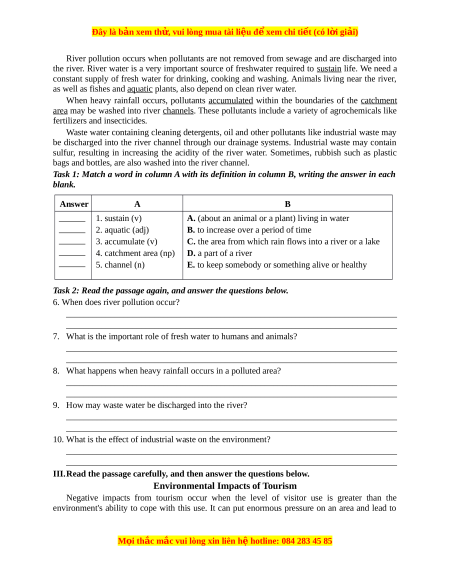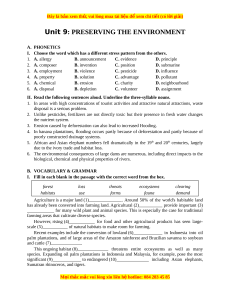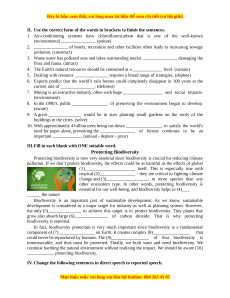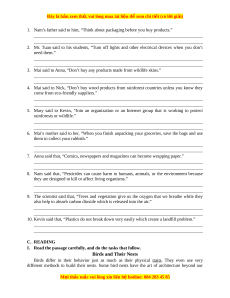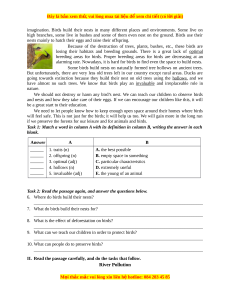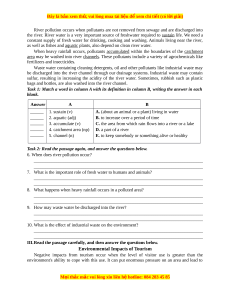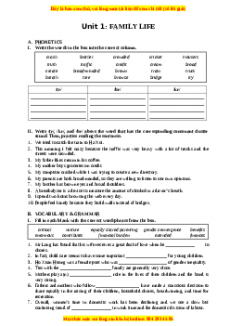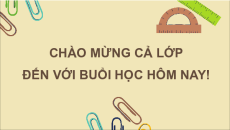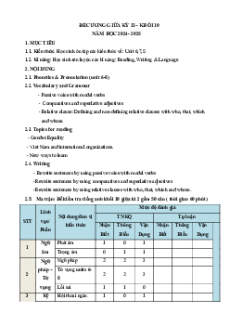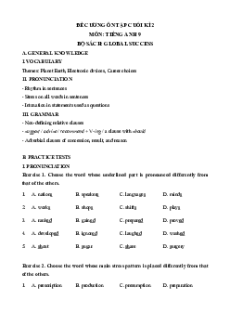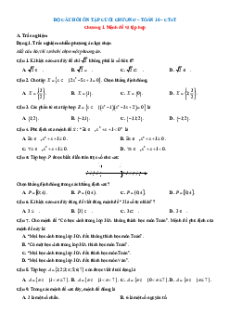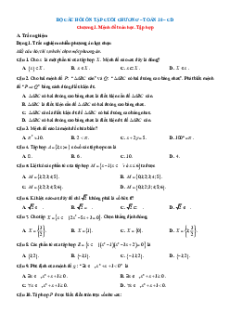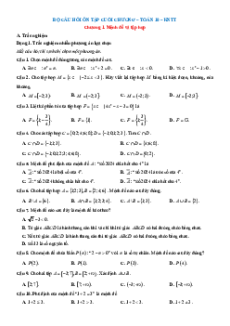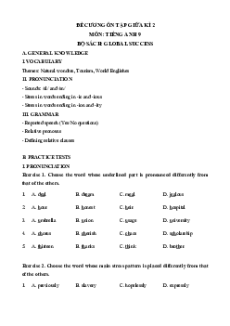Đây là bản xem th , vu ử i lòng mua tài li u ệ đ xe ể m chi ti t ế (có l i ờ gi i ả )
Unit 9: PRESERVING THE ENVIRONMENT A. PHONETICS
I. Choose the word which has a different stress pattern from the others. 1. A. allergy B. announcement C. evidence D. principle 2. A. composer B. invention C. position D. submarine 3. A. employment B. violence C. pesticide D. influence 4. A. property B. solution C. advantage D. pollutant 5. A. chemical B. erosion C. charity D. neighbourhood 6. A. disposal B. depletion C. volunteer D. assignment
II. Read the following sentences aloud. Underline the three-syllable nouns.
1. In areas with high concentrations of tourist activities and attractive natural attractions, waste disposal is a serious problem.
2. Unlike pesticides, fertilizers are not directly toxic but their presence in fresh water changes the nutrient system.
3. Erosion caused by deforestation can also lead to increased Hooding.
4. In banana plantations, flooding occurs partly because of deforestation and partly because of
poorly constructed drainage systems.
5. African and Asian elephant numbers fell dramatically in the 19th and 20th centuries, largely
due to the ivory trade and habitat loss.
6. The environmental consequences of large dams are numerous, including direct impacts to the
biological, chemical and physical properties of rivers. B. VOCABULARY & GRAMMAR
I. Fill in each blank in the passage with the correct word from the box. forest loss threats ecosystems clearing habitats use farms fauna demand
Agriculture is a major land (1)
. Around 50% of the world's habitable land
has already been converted into farming land. Agricultural (2) provide important (3)
for many wild plant and animal species. This is especially the case for traditional
farming areas that cultivate diverse species. However, rising (4)
for food and other agricultural products has seen large- scale (5)
of natural habitats to make room for farming.
Recent examples include the conversion of lowland (6) in Indonesia into oil
palm plantations, and of large areas of the Amazon rainforest and Brazilian savanna to soybean and cattle (7) . This ongoing habitat (8)
threatens entire ecosystems as well as many
species. Expanding oil palm plantations in Indonesia and Malaysia, for example, pose the most significant (9) to endangered (10) including Asian elephants,
Sumatran rhinoceros, and tigers. M i
ọ thắc mắc vui lòng xin liên h h
ệ otline: 084 283 45 85
Đây là bản xem th , vu ử i lòng mua tài li u ệ đ xe ể m chi ti t ế (có l i ờ gi i ả )
II. Use the correct form of the words in brackets to finish the sentences.
1. Air-conditioning systems have chlorofluorocarbon that is one of the well-known environmental . (polute) 2.
of hotels, recreation and other facilities often leads to increasing sewage pollution. (construct)
3. Waste water has polluted seas and lakes surrounding tourist , damaging the flora and fauna. (attract)
4. The Earth's natural resources should be consumed at a level. (sustain) 5. Dealing with resource
requires a broad range of strategies. (deplete)
6. Experts predict that the world’s rain forests could completely disappear in 100 years at the current rate of . (deforest)
7. Mining is an extractive industry, often with huge and social impacts. (environment) 8. In the 1990’s, public
of preserving the environment began to develop. (aware) 9. A great
would be to start planting small gardens on the roofs of the
buildings in the cities. (solve)
10. With approximately 4 billion trees being cut down to satisfy the world's
need for paper alone, preventing the of forests continues to be an important . (annual - deplete - prior)
III.Fill in each blank with ONE suitable word. Protecting Biodiversity
Protecting biodiversity is now very essential since biodiversity is crucial for reducing climate
pollution. If we don’t protect biodiversity, the effects could be as harmful as the effects of global (1)
itself. This is especially true with tropical (2)
- they are critical to fighting climate change and (3) to more species than any
other ecosystem type. In other words, protecting biodiversity is
essential for our well-being, and biodiversity helps to (4) the nature.
Biodiversity is an important part of sustainable development. As we know, sustainable
development is considered as a major target for industry as well as planning system. However, the only (5)
to achieve this target is to protect biodiversity. Tiny plants that grow also absorb large (6)
of carbon dioxide. That is why protecting biodiversity is essential.
In fact, biodiversity protection is very much important since biodiversity is a fundamental component of (7)
on Earth. It creates complex (8) that
could never be reproduced by humans. The (9) of that biodiversity is
immeasurable, and thus must be protected. Finally, we both want and need biodiversity. We
continue harming the natural environment without realizing the impact. We should be aware (10) protecting biodiversity.
IV. Change the following sentences in direct speech to reported speech. M i
ọ thắc mắc vui lòng xin liên h h
ệ otline: 084 283 45 85
Đây là bản xem th , vu ử i lòng mua tài li u ệ đ xe ể m chi ti t ế (có l i ờ gi i ả )
1. Nam’s father said to him, “Think about packaging before you buy products.”
___________________________________________________________________________
___________________________________________________________________________
2. Mr. Tuan said to his students, “Turn off lights and other electrical devices when you don’t need them.”
___________________________________________________________________________
___________________________________________________________________________
3. Mai said to Anna, “Don’t buy any products made from wildlife skins.”
___________________________________________________________________________
___________________________________________________________________________
4. Mai said to Nick, “Don’t buy wood products from rainforest countries unless you know they
come from eco-friendly suppliers.”
___________________________________________________________________________
___________________________________________________________________________
5. Mary said to Kevin, “Join an organization or an Internet group that is working to protect rainforests or wildlife.”
___________________________________________________________________________
___________________________________________________________________________
6. Mai’s mother said to her, “When you finish unpacking your groceries, save the bags and use
them to collect your rubbish.”
___________________________________________________________________________
___________________________________________________________________________
7. Anna said that, “Comics, newspapers and magazines can become wrapping paper.”
___________________________________________________________________________
___________________________________________________________________________
8. Nam said that, “Pesticides can cause harm to humans, animals, or the environment because
they are designed to kill or affect living organisms.”
___________________________________________________________________________
___________________________________________________________________________
9. The scientist said that, “Trees and vegetation give us the oxygen that we breathe while they
also help to absorb carbon dioxide which is released into the air.”
___________________________________________________________________________
___________________________________________________________________________
10. Kevin said that, “Plastics do not break down very easily which create a landfill problem.”
___________________________________________________________________________
___________________________________________________________________________ C. READING
I. Read the passage carefully, and do the tasks that follow. Birds and Their Nests
Birds differ in their behavior just as much as their physical traits. They even use very
different methods to build their nests. Some bird nests have the art of architecture beyond our M i
ọ thắc mắc vui lòng xin liên h h
ệ otline: 084 283 45 85
Đây là bản xem th , vu ử i lòng mua tài li u ệ đ xe ể m chi ti t ế (có l i ờ gi i ả )
imagination. Birds build their nests in many different places and environments. Some live on
high branches, some live in bushes and some of them even nest on the ground. Birds use their
nests mainly to hatch their eggs and raise their offspring.
Because of the destruction of trees, plants, bushes, etc., these birds are
losing their habitats and breeding grounds. There is a great lack of optimal
breeding areas for birds. Proper breeding areas for birds are decreasing at an
alarming rate. Nowadays, it is hard for birds to find even the space to build nests.
Some birds build nests on naturally formed tree hollows on ancient trees.
But unfortunately, there are very less old trees left in our country except rural areas. Ducks are
going towards extinction because they build their nest on old trees using the hollows, and we
have almost no such trees. We know that birds play an invaluable and irreplaceable role in nature.
We should not destroy or harm any bird’s nest. We can teach our children to observe birds
and nests and how they take care of their eggs. If we can encourage our children like this, it will
be a great start to their education.
We need to let people know how to keep enough open space around their homes where birds
will feel safe. This is not just for the birds; it will help us too. We will gain more in the long run
if we preserve the forests for our leisure and for animals and birds.
Task 1: Match a word in column A with its definition in column B, writing the answer in each blank. Answer A B 1. traits (n) A. the best possible 2. offspring (n)
B. empty space in something 3. optimal (adj)
C. particular characteristics 4. hollows (n) D. extremely useful 5. invaluable (adj)
E. the young of an animal
Task 2: Read the passage again, and answer the questions below.
6. Where do birds build their nests?
___________________________________________________________________________
7. What do birds build their nests for?
___________________________________________________________________________
8. What is the effect of deforestation on birds?
___________________________________________________________________________
9. What can we teach our children in order to protect birds?
___________________________________________________________________________
10. What can people do to preserve birds?
___________________________________________________________________________
II. Read the passage carefully, and do the tasks that follow. River Pollution M i
ọ thắc mắc vui lòng xin liên h h
ệ otline: 084 283 45 85
Bài tập Unit 9: Preserving the environment Tiếng Anh 10 chương trình thí điểm
869
435 lượt tải
MUA NGAY ĐỂ XEM TOÀN BỘ TÀI LIỆU
CÁCH MUA:
- B1: Gửi phí vào TK:
1133836868- CT TNHH DAU TU VA DV GD VIETJACK - Ngân hàng MB (QR) - B2: Nhắn tin tới Zalo VietJack Official ( nhấn vào đây ) để xác nhận thanh toán và tải tài liệu - giáo án
Liên hệ ngay Hotline hỗ trợ: 084 283 45 85
Tài liệu được cập nhật liên tục trong gói này từ nay đến hết tháng 6/2023. Chúng tôi đảm bảo đủ số lượng đề đã cam kết hoặc có thể nhiều hơn, tất cả có BẢN WORD, LỜI GIẢI CHI TIẾT và tải về dễ dàng.
Để tải tài liệu gốc về máy bạn click vào nút Tải Xuống ở trên!
Thuộc bộ (mua theo bộ để tiết kiệm hơn):
- Tailieugiaovien.com.vn giới thiệu Bộ bài tập trắc nghiệm Tiếng Anh lớp 10 chương trình thí điểm mới nhất năm 2022 - 2023 nhằm giúp Giáo viên có thêm tài liệu tham khảo bài tập Tiếng Anh lớp 10.
- File word có lời giải chi tiết 100%.
- Mua trọn bộ sẽ tiết kiệm hơn tải lẻ 50%.
Đánh giá
4.6 / 5(869 )5
4
3
2
1
Trọng Bình
Tài liệu hay
Giúp ích cho tôi rất nhiều
Duy Trần
Tài liệu chuẩn
Rất thích tài liệu bên VJ soạn (bám sát chương trình dạy)
TÀI LIỆU BỘ BÁN CHẠY MÔN Tiếng Anh
Xem thêmTÀI LIỆU BỘ BÁN CHẠY Lớp 10
Xem thêmTài liệu bộ mới nhất

Đây là b n xem th , vui lòng mua tài li u đ xem chi ti t (có l i gi i)ả ử ệ ể ế ờ ả
Unit 9: PRESERVING THE ENVIRONMENT
A. PHONETICS
I. Choose the word which has a different stress pattern from the others.
1. A. allergy B. announcement C. evidence D. principle
2. A. composer B. invention C. position D. submarine
3. A. employment B. violence C. pesticide D. influence
4. A. property B. solution C. advantage D. pollutant
5. A. chemical B. erosion C. charity D. neighbourhood
6. A. disposal B. depletion C. volunteer D. assignment
II. Read the following sentences aloud. Underline the three-syllable nouns.
1. In areas with high concentrations of tourist activities and attractive natural attractions, waste
disposal is a serious problem.
2. Unlike pesticides, fertilizers are not directly toxic but their presence in fresh water changes
the nutrient system.
3. Erosion caused by deforestation can also lead to increased Hooding.
4. In banana plantations, flooding occurs partly because of deforestation and partly because of
poorly constructed drainage systems.
5. African and Asian elephant numbers fell dramatically in the 19
th
and 20
th
centuries, largely
due to the ivory trade and habitat loss.
6. The environmental consequences of large dams are numerous, including direct impacts to the
biological, chemical and physical properties of rivers.
B. VOCABULARY & GRAMMAR
I. Fill in each blank in the passage with the correct word from the box.
Agriculture is a major land (1) . Around 50% of the world's habitable land
has already been converted into farming land. Agricultural (2) provide important (3)
for many wild plant and animal species. This is especially the case for traditional
farming areas that cultivate diverse species.
However, rising (4) for food and other agricultural products has seen large-
scale (5) of natural habitats to make room for farming.
Recent examples include the conversion of lowland (6) in Indonesia into oil
palm plantations, and of large areas of the Amazon rainforest and Brazilian savanna to soybean
and cattle (7) .
This ongoing habitat (8) threatens entire ecosystems as well as many
species. Expanding oil palm plantations in Indonesia and Malaysia, for example, pose the most
significant (9) to endangered (10) including Asian elephants,
Sumatran rhinoceros, and tigers.
M i th c m c vui lòng xin liên h hotline: 084 283 45 85ọ ắ ắ ệ
forest loss threats ecosystems clearing
habitats use farms fauna demand

Đây là b n xem th , vui lòng mua tài li u đ xem chi ti t (có l i gi i)ả ử ệ ể ế ờ ả
II. Use the correct form of the words in brackets to finish the sentences.
1. Air-conditioning systems have chlorofluorocarbon that is one of the well-known
environmental . (polute)
2. of hotels, recreation and other facilities often leads to increasing sewage
pollution. (construct)
3. Waste water has polluted seas and lakes surrounding tourist , damaging the
flora and fauna. (attract)
4. The Earth's natural resources should be consumed at a level. (sustain)
5. Dealing with resource requires a broad range of strategies. (deplete)
6. Experts predict that the world’s rain forests could completely disappear in 100 years at the
current rate of . (deforest)
7. Mining is an extractive industry, often with huge and social impacts.
(environment)
8. In the 1990’s, public of preserving the environment began to develop.
(aware)
9. A great would be to start planting small gardens on the roofs of the
buildings in the cities. (solve)
10. With approximately 4 billion trees being cut down to satisfy the world's
need for paper alone, preventing the of forests continues to be an
important . (annual - deplete - prior)
III.Fill in each blank with ONE suitable word.
Protecting Biodiversity
Protecting biodiversity is now very essential since biodiversity is crucial for reducing climate
pollution. If we don’t protect biodiversity, the effects could be as harmful as the effects of global
(1) itself. This is especially true with
tropical (2) - they are critical to fighting climate
change and (3) to more species than any
other ecosystem type. In other words, protecting biodiversity is
essential for our well-being, and biodiversity helps to (4)
the nature.
Biodiversity is an important part of sustainable development. As we know, sustainable
development is considered as a major target for industry as well as planning system. However,
the only (5) to achieve this target is to protect biodiversity. Tiny plants that
grow also absorb large (6) of carbon dioxide. That is why protecting
biodiversity is essential.
In fact, biodiversity protection is very much important since biodiversity is a fundamental
component of (7) on Earth. It creates complex (8) that
could never be reproduced by humans. The (9) of that biodiversity is
immeasurable, and thus must be protected. Finally, we both want and need biodiversity. We
continue harming the natural environment without realizing the impact. We should be aware (10)
protecting biodiversity.
IV. Change the following sentences in direct speech to reported speech.
M i th c m c vui lòng xin liên h hotline: 084 283 45 85ọ ắ ắ ệ

Đây là b n xem th , vui lòng mua tài li u đ xem chi ti t (có l i gi i)ả ử ệ ể ế ờ ả
1. Nam’s father said to him, “Think about packaging before you buy products.”
___________________________________________________________________________
___________________________________________________________________________
2. Mr. Tuan said to his students, “Turn off lights and other electrical devices when you don’t
need them.”
___________________________________________________________________________
___________________________________________________________________________
3. Mai said to Anna, “Don’t buy any products made from wildlife skins.”
___________________________________________________________________________
___________________________________________________________________________
4. Mai said to Nick, “Don’t buy wood products from rainforest countries unless you know they
come from eco-friendly suppliers.”
___________________________________________________________________________
___________________________________________________________________________
5. Mary said to Kevin, “Join an organization or an Internet group that is working to protect
rainforests or wildlife.”
___________________________________________________________________________
___________________________________________________________________________
6. Mai’s mother said to her, “When you finish unpacking your groceries, save the bags and use
them to collect your rubbish.”
___________________________________________________________________________
___________________________________________________________________________
7. Anna said that, “Comics, newspapers and magazines can become wrapping paper.”
___________________________________________________________________________
___________________________________________________________________________
8. Nam said that, “Pesticides can cause harm to humans, animals, or the environment because
they are designed to kill or affect living organisms.”
___________________________________________________________________________
___________________________________________________________________________
9. The scientist said that, “Trees and vegetation give us the oxygen that we breathe while they
also help to absorb carbon dioxide which is released into the air.”
___________________________________________________________________________
___________________________________________________________________________
10. Kevin said that, “Plastics do not break down very easily which create a landfill problem.”
___________________________________________________________________________
___________________________________________________________________________
C. READING
I. Read the passage carefully, and do the tasks that follow.
Birds and Their Nests
Birds differ in their behavior just as much as their physical traits. They even use very
different methods to build their nests. Some bird nests have the art of architecture beyond our
M i th c m c vui lòng xin liên h hotline: 084 283 45 85ọ ắ ắ ệ

Đây là b n xem th , vui lòng mua tài li u đ xem chi ti t (có l i gi i)ả ử ệ ể ế ờ ả
imagination. Birds build their nests in many different places and environments. Some live on
high branches, some live in bushes and some of them even nest on the ground. Birds use their
nests mainly to hatch their eggs and raise their offspring.
Because of the destruction of trees, plants, bushes, etc., these birds are
losing their habitats and breeding grounds. There is a great lack of optimal
breeding areas for birds. Proper breeding areas for birds are decreasing at an
alarming rate. Nowadays, it is hard for birds to find even the space to build nests.
Some birds build nests on naturally formed tree hollows on ancient trees.
But unfortunately, there are very less old trees left in our country except rural areas. Ducks are
going towards extinction because they build their nest on old trees using the hollows, and we
have almost no such trees. We know that birds play an invaluable and irreplaceable role in
nature.
We should not destroy or harm any bird’s nest. We can teach our children to observe birds
and nests and how they take care of their eggs. If we can encourage our children like this, it will
be a great start to their education.
We need to let people know how to keep enough open space around their homes where birds
will feel safe. This is not just for the birds; it will help us too. We will gain more in the long run
if we preserve the forests for our leisure and for animals and birds.
Task 1: Match a word in column A with its definition in column B, writing the answer in each
blank.
Task 2: Read the passage again, and answer the questions below.
6. Where do birds build their nests?
___________________________________________________________________________
7. What do birds build their nests for?
___________________________________________________________________________
8. What is the effect of deforestation on birds?
___________________________________________________________________________
9. What can we teach our children in order to protect birds?
___________________________________________________________________________
10. What can people do to preserve birds?
___________________________________________________________________________
II. Read the passage carefully, and do the tasks that follow.
River Pollution
M i th c m c vui lòng xin liên h hotline: 084 283 45 85ọ ắ ắ ệ
Answer A B
1. traits (n)
2. offspring (n)
3. optimal (adj)
4. hollows (n)
5. invaluable (adj)
A. the best possible
B. empty space in something
C. particular characteristics
D. extremely useful
E. the young of an animal

Đây là b n xem th , vui lòng mua tài li u đ xem chi ti t (có l i gi i)ả ử ệ ể ế ờ ả
River pollution occurs when pollutants are not removed from sewage and are discharged into
the river. River water is a very important source of freshwater required to sustain life. We need a
constant supply of fresh water for drinking, cooking and washing. Animals living near the river,
as well as fishes and aquatic plants, also depend on clean river water.
When heavy rainfall occurs, pollutants accumulated within the boundaries of the catchment
area may be washed into river channels. These pollutants include a variety of agrochemicals like
fertilizers and insecticides.
Waste water containing cleaning detergents, oil and other pollutants like industrial waste may
be discharged into the river channel through our drainage systems. Industrial waste may contain
sulfur, resulting in increasing the acidity of the river water. Sometimes, rubbish such as plastic
bags and bottles, are also washed into the river channel.
Task 1: Match a word in column A with its definition in column B, writing the answer in each
blank.
Task 2: Read the passage again, and answer the questions below.
6. When does river pollution occur?
___________________________________________________________________________
___________________________________________________________________________
7. What is the important role of fresh water to humans and animals?
___________________________________________________________________________
___________________________________________________________________________
8. What happens when heavy rainfall occurs in a polluted area?
___________________________________________________________________________
___________________________________________________________________________
9. How may waste water be discharged into the river?
___________________________________________________________________________
___________________________________________________________________________
10. What is the effect of industrial waste on the environment?
___________________________________________________________________________
___________________________________________________________________________
III.Read the passage carefully, and then answer the questions below.
Environmental Impacts of Tourism
Negative impacts from tourism occur when the level of visitor use is greater than the
environment's ability to cope with this use. It can put enormous pressure on an area and lead to
M i th c m c vui lòng xin liên h hotline: 084 283 45 85ọ ắ ắ ệ
Answer A B
1. sustain (v)
2. aquatic (adj)
3. accumulate (v)
4. catchment area (np)
5. channel (n)
A. (about an animal or a plant) living in water
B. to increase over a period of time
C. the area from which rain flows into a river or a lake
D. a part of a river
E. to keep somebody or something alive or healthy
